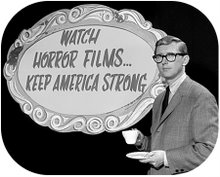
The official Oscar hype season has begun, and silent film homage The Artist looks like the sentimental favorite. I haven't seen it yet, so I'll refrain from knocking it, but several critics I admire, as well as Kim Novak, have taken issue with its appropriation of large chunks of Bernard Herrmann's music for Hitchcock's Vertigo to score much of the film's final third. Since I haven't seen it, I don't have an opinion yet, but I'm puzzled by what I've read. That score has about as much to do with silent film as a Jay-Z video or a super-talky Aaron Sorkin-scripted project, etc. I'm sure plenty of people will congratulate themselves on seeing The Artist and recognizing a connection, however revisionist, to the early days of film, but will it inspire anyone to actually, you know, seek out and watch authentic silent films from the first 30 years of the medium? Is it just more faddish costume-party pastiche?

I know silent films are a hard sell for most people. When I first began learning about film history, I had a tough time watching silents. The poor quality of a lot of silent film prints, the sometimes comically exaggerated gestures of the performers, the quaintly worded title cards, the jarring absence of human voices (or any diegetic sound, for that matter), the cultural distance between silent and sound film (for me, even an early 1930s film seems relatable and connected to the world we currently inhabit, but silents seem like found footage from some distant ancestral time): watching these films seemed more like necessary work than pleasure. I stuck with it, though, and I began to appreciate, enjoy, and occasionally even love many silent films and filmmakers, especially F.W. Murnau, D.W. Griffith, Erich Von Stroheim, Louis Feuillade, and Buster Keaton, and the pre-sound films of Charlie Chaplin, Carl Dreyer, Alfred Hitchcock, Fritz Lang, Yasujiro Ozu, King Vidor, Ernst Lubitsch, and Josef Von Sternberg.

Silent film at its best can put the viewer in an almost hypnotic state, a weird place between the dreaming and waking world, and is ideally suited to horror. Some of the best silent films are horror movies or contain horror elements. Murnau's Nosferatu was the first silent film that really drew me in and made me forget about the absence of sound. John S. Robertson's take on Robert Louis Stevenson's classic Jekyll and Hyde story is not a masterpiece like Murnau's vampire film, but it is most definitely worth seeing, particularly for the delightfully creepy performance of John Barrymore (Drew's grandpa) in the dual title role. This is a briskly paced film with great atmosphere and clever use of minimal sets.

I think we're all familiar with the plot, so I'll spare you a description. This mostly faithful film departs from Stevenson's book by using two characters added in an 1887 stage play: Millicent, the daughter of Sir George Carew, who is engaged to Jekyll, and Miss Gina, a dance hall singer who gets involved with Hyde. These added elements have become such a part of the story that they often appear in subsequent adaptations. Unlike some poor-quality silents, the cast here realizes it's on film and doesn't mug for the back row, although Barrymore does go cuckoo-bananas when he drinks the potion. The transformation into Hyde is a marvel of performance. Using just a little makeup and some bizarrely oversized prosthetic hands, Barrymore makes his Hyde a lecherous, menacing, leering, disfigured walking id, hunched into himself, grinning with huge teeth, reaching out with those bizarro-world hands, indulging every impulse. A scene where he stomps on a small homeless boy is a hugely enjoyable celebration of evil. Barrymore is genuinely unsettling in the part. This is not a dated, archaic performance. It still works.

Robertson shot on a set with just a few artificial buildings and streets, but he fills them with such a sense of geography and lived-in presence that you almost forget it's not a real London street. Jekyll's home and laboratory, Carew's entertaining room, a seedy bar presided over by a top-hatted MC who bangs a gavel on his table to get the room's attention, a dirty street and flophouse where Hyde stays. These locations are given life by the film's subtle camerawork and detailed set decorations. It's a good-looking movie.

John S. Robertson, a Canadian, began his film career in 1916 and quickly became a prolific Hollywood director throughout the silent era. Dr. Jekyll and Mr. Hyde was his most successful film. When sound replaced the silents in the early 1930s, Robertson continued working for a handful of years, making one of the earliest Little Orphan Annie films in 1932. He retired in 1935, concluding his career with a Shirley Temple movie, Our Little Girl. I wasn't able to find out if the experience of working with Shirley Temple drove him out of the business forever or if he'd already planned his retirement, but he never made another film in the 29 of his remaining years.
Fun facts: Notable classical composer Edgard Varese has a bit part in this film as a policeman. The Byrds' song "Old John Robertson" is about John S. Robertson, who retired in the same Southern California neighborhood where future Byrds/Flying Burrito Brothers member Chris Hillman grew up. According to Hillman, Robertson had a huge personality and was famous around town for both his career as a former silent film director and his large handlebar mustache and 1920s clothes.













